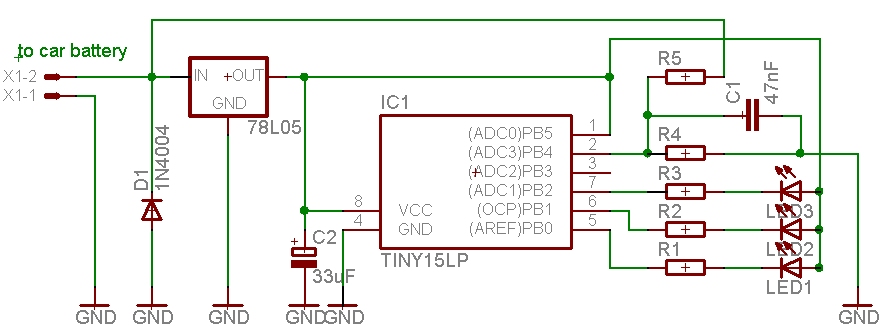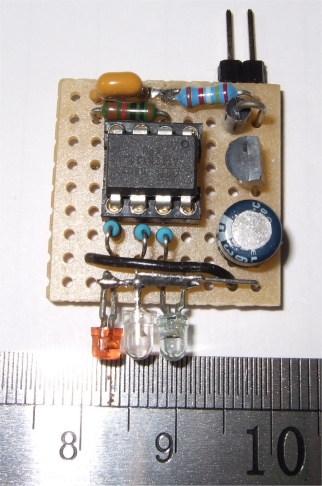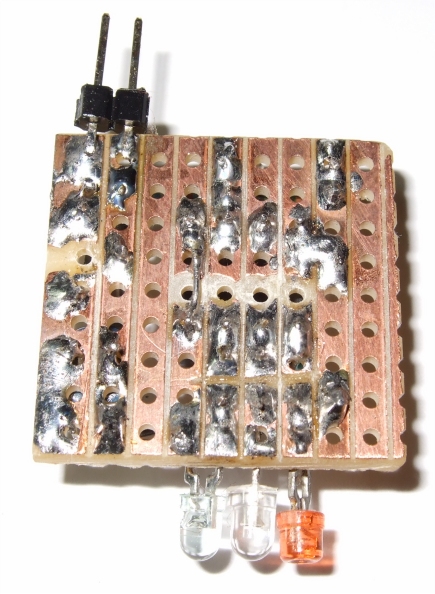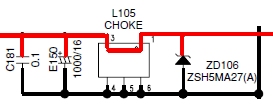Car Voltmeter with ATtiny15
This is not a real voltmeter but more an indicator for the battery voltage with 3 leds.
I'm using it in my car and with a quick glance I can see it's all green and the battery is ok, easier than to read a display in heavy traffic. It could be done differently by why not give some task to the old workhorse ATtiny15.
It is reading the battery voltage with ADC3 and a voltage divider, R5 is 24.8k (sorry) and R4 is 10k to GND. Then there are some thresholds defined in the assembler program and a red, green, and yellow led is turned on depending on the voltage: red below 10 V, red&green 11.5V, green between 12 and 13.8V and yellow above 14V. Nice and easy. With another voltage divider just redefine the thresholds. There is a reverse diode at the input to protect against spikes in a car. It might be wise to add a 10 Ohm resistor in front, but it works like this in my car and has not blown a fuse yet.

The circuit diagram of the so-called car voltmeter, PB0 and R1 (470Ohm) go to the red LED1, LED2 is green and LED3 is yellow
It might be build even smaller than you see here and could fit in the plug of the cigarette lighter. I drilled holes in the dashboard, it's an old car.


A possible layout of the board, top and bottom view.
It is a quick and easy project but once you have it you'll find it useful.
download 3led12V2.asm
This program is distributed in the hope that it will be useful but WITHOUT
ANY WARRANTY;
References
Atmel datasheet ATtiny15, Atmel.com
Gerd's AVR assembler version 2.7: http://www.avr-asm-tutorial.net/gavrasm/index_en.html
Nachtrag: Sebastian Heyn wies darauf hin, dass die Schaltung nicht gegen Spannungsspitzen geschützt ist, wie es im Automotive-Bereich üblich ist. Man kann z.B. eine Suppressordiode mit einem Vorwiderstand einsetzen. Üblich ist auch eine Induktivität in der Versorgungsleitung. Bei privaten Spielereien kann man die Schaltspannung vom Radio (für externe Verstärker oder Phantomspeisung) nehmen, die ist fast immer durch die Schutzmechanismen des Radios mitgeschützt.
;***************************************************************************
; AT15 3 Leds on PB 0 1 2, red green yellow, use threshold
; simple car Voltmeter, 12 V, indicate battery voltage
; The timing is adapted for 1.6 MHz
; OSCCAL config val=0x74 (not critical)
; ATtiny15 GS 2009
;
;***************************************************************************
;
; This program is free software; you can redistribute it and/or
; modify it under the terms of the GNU General Public License.
; This program is distributed in the hope that it will be useful,
; but WITHOUT ANY WARRANTY;
;***************************************************************************
; ATtiny15 dip
; (RESET/ADC0) PB5 VCC
; (ADC3) PB4 PB2 (ADC1/SCK/T0/INT0)
; (ADC2) PB3 PB1 (AIN1/MISO/OC1A)
; GND PB0 (AIN0/AREF/MOSI)
;
;***************************************************************************
; voltage divider 10 k & 24.8 k on ADC3, 24,8k => 100k parallel 33k
;***************************************************************************
.DEVICE ATtiny15 ;for gavrasm
.equ avgcnt = 16
;Led Voltin
.equ Volt1 = 176 ;red 10
.equ Volt2 = 191 ;redgn 11.5
.equ Volt3 = 197 ;gn 12
.equ Volt4 = 217 ;gn 13.8
.equ Volt5 = 220 ;yel 14
.equ toggle = PB3
;***************************************************************************
.def zero = r14
.def S = r15
.def temp = r16
.def count = r17
.def lcnt = r18
.def next_step = r19
.def av_l = r20 ; Average Low Byte (ADC Measurement)
.def av_h = r21 ; Average High Byte (ADC Measurement)
.def ledflag = R22 ; set Leds
.cseg
.org 0
; Reset-vector to adress 0000
rjmp reset
reti ; INT0addr= 0x0001 External Interrupt 0
reti ; PCI0addr= 0x0002 Pin Change Interrupt
reti ; OC1addr = 0x0003 Timer/Counter1 Compare Match
reti ; OVF1addr= 0x0004 Timer/Counter1 Overflow
rjmp TIM0_OVF ; OVF0addr= 0x0005 Timer/Counter0 Overflow
reti ; ERDYaddr= 0x0006 EEPROM Ready
reti ; ACIaddr = 0x0007 Analog Comparator
reti ; ADCCaddr= 0x0008 ADC Conversion Ready
;***************************************************************************
;* "TIM0_OVF" - Timer/counter overflow interrupt handler
;*
;* The overflow interrupt toggles every 1.28ms
;*
;***************************************************************************
TIM0_OVF: in S,sreg ; Updated every 1.28 ms, calibrate OSCCAL
sbis PINB, toggle ; skip if set
sbi PORTB, toggle ; set output PORTB
sbic PINB, toggle ; skip if set
cbi PORTB, toggle
inc count
inc next_step
out sreg,S
reti
;***************************************************************************
reset:
; writing the calibration byte to the OSCCAL Register.
; ldi temp,0x74 ; test
; out OSCCAL,temp ; for the clock
; nop
; nop
; Port B
ldi temp,0b00001111 ; set hi
out PORTB, temp ; 1 = pull-up , 0 = float
ldi temp,0b00001111 ; low 4 bits are 1 = output
out DDRB, temp ; to data direction register
;***************************************************************************
; AD-Converter setup:
; ADMUX: REFS1 REFS0 ADLAR – – MUX2 MUX1 MUX0
; If ADLAR is set, the result is left-adjusted.
ldi temp, 0b00100011 ; Ch 3 input=PB4, REFS0,1 =00 Vcc is RefVoltage
out ADMUX, temp
; ADCSR: ADEN ADSC ADFR ADIF ADIE ADPS2 ADPS1 ADPS0
ldi temp, 0b11010011 ; ADC init single conversion prescaler 8:
out ADCSR, temp
;***************************************************************************
; timer setup:
ldi temp,0b00000010 ; Timer/Counter 0 clocked at CK/8 = 5 us
out TCCR0,temp ; 1,6 Mhz
;Bit 1 – TOIE0: Timer/Counter0 Overflow Interrupt Enable
ldi temp,0b00000010 ; $02 set Bit 1
out TIMSK,temp ; in the Timer Interupt Mask Register
out TCNT0,zero ; Timer/Counter 0 clear
sbi AcsR,Acd ; Disable Comparator
clr av_l
clr av_h ; Clear Average Registers
clr next_step
sei ; Enable gobal interrupt
;***************************************************************************
out PORTB,zero ; test leds, all on
clr next_step
test: cpi next_step, 250 ; short test
brne test
clr next_step
main: cpi next_step, 8 ; update time
brne main
clr next_step
rcall convert_average ; Measure Volt 0..255
ser ledflag ; all 1 = leds off
cpi av_l, Volt1 ; threshold 10 V
brsh m2 ; next
cbr ledflag, 1 ; is below 10 V, turn led on
rjmp mx
m2: cpi av_l, Volt2 ; threshold 11.5
brsh m3 ; next
cbr ledflag, 1
rjmp mx
m3: cpi av_l, Volt3 ; threshold 12
brsh m4 ; next
cbr ledflag, 3
rjmp mx
m4: cpi av_l, Volt4 ; threshold 13.8
brsh m5 ; next
cbr ledflag, 2
rjmp mx
m5: cpi av_l, Volt5 ; threshold 14
brsh m6 ; next
cbr ledflag, 6
rjmp mx
m6:
cbr ledflag, 4
mx:
out PORTB,ledflag ;
rjmp main
;***************************************************************************
; ADC Average
; function measures the voltage Vin and returns the
; average value in av_l 0..255, avgcnt=16
;***************************************************************************
convert_average:
ldi temp,0b00100011
out ADMUX, temp ; Set ADC Channel
clr av_l
clr av_h ; Clear Average Registers
ldi lcnt,avgcnt ; Set loop counter
convert_start:
ldi temp,0b11010011 ;
out ADCSR,temp ; Start A/D Conversions
convert_wait:
sbis ADCSR, ADIF
rjmp convert_wait ; Wait for Conversion to finish
in temp, ADCH
add av_l, temp
adc av_h, zero ; Add measured value to average
dec lcnt
brne convert_start ; Repeat lcnt times
ldi lcnt,avgcnt/4 ; Set shift counter
convert_avg:
lsr av_h
ror av_l ; av_h:av_l = av_h:av_l/2
dec lcnt
brne convert_avg ; Repeat (avg_loop_cnt) times
;cbi ADCSR,ADEN
ret ; return to measure

